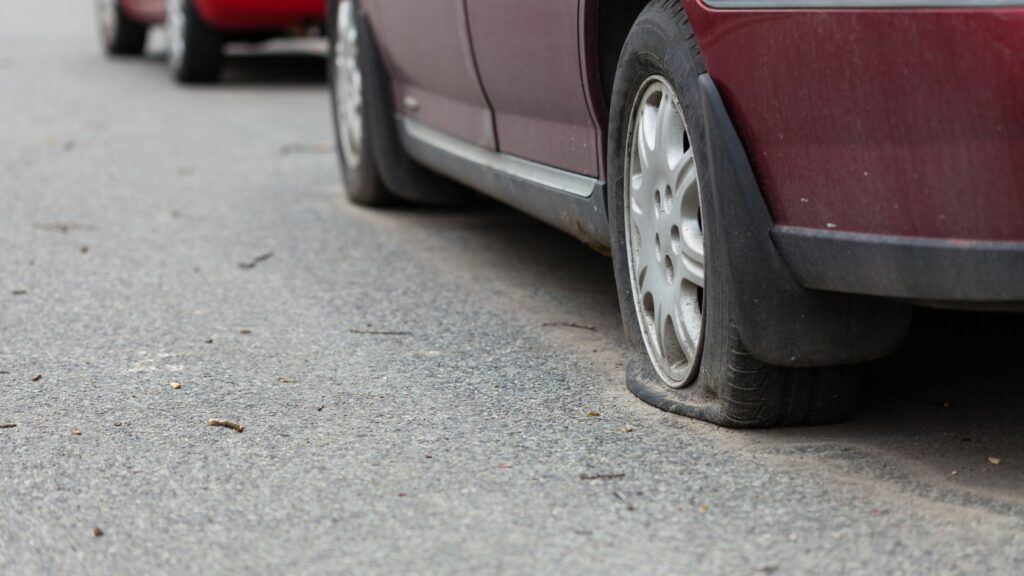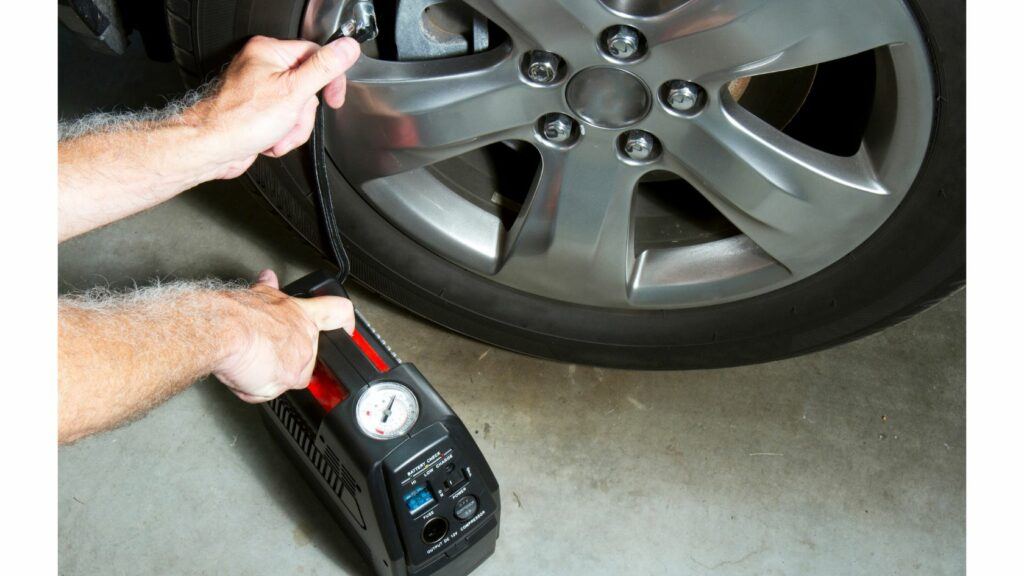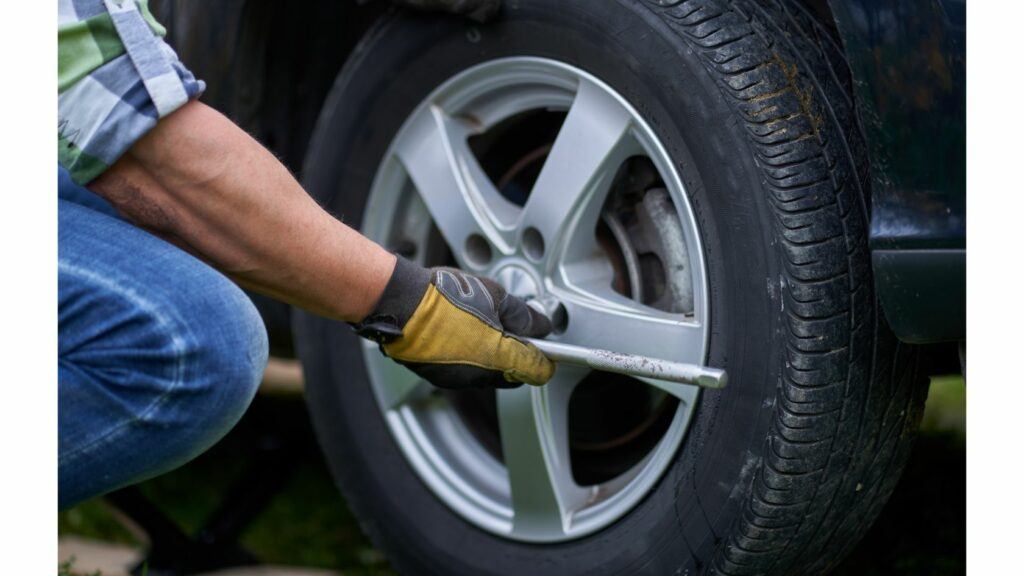
In recent years, run-flat tires have gained popularity for their unique features and benefits. Run-flat tires are designed to run deflated, making us wonder, “Can you fill run-flat tires when they go out of air?”
To answer the above question, it is essential to understand the integrity and structure of run-flat tires.
This is what we will do in this comprehensive blog guide. We will explore the world of run-flat tires, how they work, how to identify if they’re punctured, their recommended PSI, repair methods, and the pros and cons compared to regular tires.
What is a Run-Flat Tire?
A run-flat tire is designed with reinforced sidewalls that support the vehicle’s weight even when the tire is completely deflated.
This means you can continue driving on run-flat tires for a limited distance at a reduced speed after a puncture. This is in contrast to conventional pneumatic tires, which become unusable when punctured and must be replaced immediately.
In practicality, run-flat tires provide a safer option than traditional tires that can fail catastrophically when punctured.
How Do Run-Flat Tires Work?
Run-flat tires feature a stiffer sidewall, a heat-resistant rubber, and a special ring or a hole that allows the tire to support the vehicle’s weight temporarily in the event of an air loss.
The advantage of such a design is it minimizes the risk of accidents caused by sudden deflation. This helps drivers reach a nearby service station or a safe location for repairs or replacements on the same tires.
Can You Fill Run-Flat Tires?
Yes, you can fill run-flat tires when they are deflated. The process of refilling is similar to filling any other tire. You can use a standard air compressor or a tire inflator to fill the air. However, since run-flat tires are stiffer compared to regular tires, it may take longer to inflate them.

How to Know If a Run-flat Tire is Punctured?
Detecting a punctured run-flat tire can be challenging, as they don’t show obvious signs like regular tires. Still, there are a few ways you can follow to know if a run-flat tire is punctured:
Tire pressure monitoring system (TPMS) light: Most modern vehicles equipped with run-flat tires have a Tire Pressure Monitoring System (TPMS) that alerts the driver when the tire pressure is low. If the TPMS light comes on, it is possible that you have a punctured tire.
Tire pressure gauge: Use a tire pressure gauge to check the pressure in all four tires. Compare the pressure in each tire to the recommended pressure, which can be found on the driver’s side doorjamb.
If the pressure in any tire is low, inflate the tire to the recommended pressure. If the tire does not hold air, then it is likely that the tire is punctured.
Visual inspection: Check all four tires for signs of visible damage by parking the car on a level surface. If you see any visible damage to the tire, such as a nail or screw in the tread, or a bulge in the sidewall, then it is likely that the tire is punctured.
Handling: If you feel the car is vibrating or pulling to one side repeatedly, this could be another sign of a flat tire.
Noise: Unusual noises coming from the tires, such as thumping or flapping, can also be a sign of a punctured run-flat tire.
If you are unsure whether or not you have a punctured run-flat tire, it is best to err on the side of caution and have the tire inspected by a qualified tire technician.
Recommended PSI for Run-Flat Tires
The recommended PSI for run-flat tires varies depending on the make, model, and year of the vehicle. However, most run-flat tires have a recommended PSI between 32 and 36.
For accurate numbers, refer to your vehicle’s owner’s manual or the tire placard located on the driver’s side doorjamb.
In contrast to conventional tires, the recommended PSI for run-flat tires is typically higher because of their stiffer sidewalls. When inflated with higher pressure, these sidewalls support the weight of the vehicle efficiently.
Underinflated or overinflated tires can lead to uneven wear and reduced handling capabilities.
It is, therefore, crucial to maintain proper PSI by referring to the correct statistics to ensure optimal performance, longevity, and safety of these tires.
How Far Can You Drive on Run-Flat Tires?
While run-flat tires allow you to continue driving after a puncture, it’s not a limitless journey. Typically, you can go up to 50 miles at speeds around 50 mph, but this can vary based on the tire’s design, vehicle weight, and road conditions.
However, some run-flat tires may allow you to drive further or faster, depending on the factors listed above. This doesn’t mean you should drive run-flat tires indefinitely when they are flat. If you do this, the tire may overheat and fail leading to accidents.
Whenever you have a punctured run-flat tire, prefer driving to a safe location and have the tire replaced as soon as possible.
Can You Drive Run-Flat Tire With Zero Pressure?
Yes, you can drive a run-flat tire with zero pressure. However, you should only do this in an emergency situation at reduced speeds, and for a short distance.
Run-flat tires are designed to support the weight of the vehicle even when flat, but they are not designed to be driven indefinitely on a flat tire.
Are Run-Flat Tires Repairable?
Run-flat tires are repairable, but not all punctures can be fixed. Damage to the sidewall or large punctures may require replacing the tire.
Repairing run-flat tires also depends on the specific model and the extent of damage. Some tires can be repaired if the puncture is small and in the tread area.

However, most tire manufacturers do not recommend repairing run-flat tires, as the tire’s internal structure may have been damaged, even if you could drive on it for a short distance after the puncture. This damage may not be visible to the naked eye, and it could lead to a blowout in the future.
Always consult a professional technician to assess the damage and determine the appropriate course of action. If the tire can be repaired, the technician will use a special plug or patch to seal the puncture. However, if the tire cannot be repaired, you will need to replace it.
Are Run-Flat Tires Expensive?
Yes, run-flat tires are more expensive than conventional pneumatic tires.
This is because run-flat tires are engineered with advanced technology including reinforced sidewalls and heat-resistant rubber compounds to support the weight of the vehicle during deflation. This sophisticated engineering requires extensive research and development.
When it comes to manufacturing, the process for run-flat tires is more complex owing to the added layers of reinforcement and unique construction methods. This process demands precision and specialized equipment.
Manufacturing relies on material. The materials used in run-flat tires are often high-quality and durable. Superior material enhances the tire’s ability to withstand the heat and pressure generated when driving on a flat tire.
In terms of production, run-flat tires are not as common as regular tires. This means there is low demand for them which leads to higher prices since manufacturers produce them in smaller quantities. All these factors drive up the production costs of run-flat tires.
Another reason for the expensiveness is their compatibility. These tires are not available for all vehicle types and so their cost goes up with limited availability.
Run-flat tires: Pros and Cons
PROS
Enhanced safety – One of the main benefits of the run-flat tire is you can continue driving even after it has punctured. This means no losing of control and no accidents while driving.
By continuing driving, run-flat tires also give you the option to reach a safe destination to perform repairs or replacements.
Convenience – With run-flat tires, there is no need for a spare tire and the tools required to change them. These tires save drivers the time and hassle of having to change a flat tire.
The convenience of not carrying a spare tire saves space in your vehicle. It also reduces the overall weight, potentially improving fuel efficiency.
Space – No spare tire means more storage and more space. Run-flat tires allow for additional storage in the trunk which can be particularly valuable, especially in smaller vehicles where storage space is limited.
Potential cost savings – While run-flat tires have a higher initial cost, they can save money over the long term due to extended mobility after punctures.
Their ability to continue driving after a puncture means you might avoid the immediate expenses of towing or replacing a flat tire, especially in situations where reaching an auto repair shop is possible.
CONS
Limited driving distance – Even though you can drive on run-flat tires despite puncture it is not a limitless journey. Run-flat tires have a limited range (usually up to 50 miles at reduced speeds) after a puncture.
This limitation means that you still need to have the tire inspected and repaired or replaced relatively soon, which might not be possible if you are in a remote area.
Higher cost – Run-flat tires are generally more expensive to purchase than regular tires because of their construction and materials.
Additionally, if they are damaged beyond repair, replacing them can be a significant cost, especially if your vehicle requires specialized or less common tire sizes.
Reduced ride comfort – Run-flat tires can be stiffer and less comfortable than conventional pneumatic tires. The reinforced sidewalls that allow run-flat tires to support the vehicle’s weight can result in a stiffer ride.
This can make the driving experience less comfortable, especially on rough or uneven road surfaces.
Limited availability – Run-flat tires are not as widely available as regular tires. If you have a less common vehicle or specific tire requirements, finding the right run-flat tire might be challenging.
Limited availability can also affect pricing, potentially making them more expensive due to reduced competition.
Run-flat tires vs. regular tires
The choice between run-flat and regular tires depends on your driving habits, preferences, and the level of convenience you desire.
Run-flat tires offer added safety, but they come with trade-offs. Regular tires provide a smoother ride and can often be repaired multiple times if punctured.
If you are looking for a tire that can help you stay safe on the road even in the event of a flat tire, then run-flat tires are a good option to consider.
However, if you are on a budget or want the smoothest ride and the best fuel economy possible, then regular tires may be a better choice.
Here are some additional factors to consider when choosing between run-flat tires and regular tires:
- Driving habits: If you frequently drive on rough roads or in areas where there is a high risk of getting a flat tire, then run-flat tires may be a good option for you.
- Climate: Run-flat tires can be more susceptible to wear and tear in hot climates. If you live in a hot climate, you may want to consider using regular tires.
- Vehicle type: Not all vehicles are compatible with run-flat tires. If you have a sports car or a high-performance vehicle, you may need to use run-flat tires.
Final thoughts
Run-flat tires provide an innovative solution for minimizing the risks associated with tire punctures. They offer a number of advantages over regular tires including a refilling option.
However, it’s crucial to understand their limitations, maintenance requirements, and the importance of proper tire care. They are also more expensive and can reduce ride comfort and fuel economy to some extent.
Whether or not run-flat tires are right for you depends on your individual needs and priorities.
Regardless of the type of tire you choose, regular inspections, proper maintenance, and attentive driving are essential for a safe and enjoyable driving experience.
